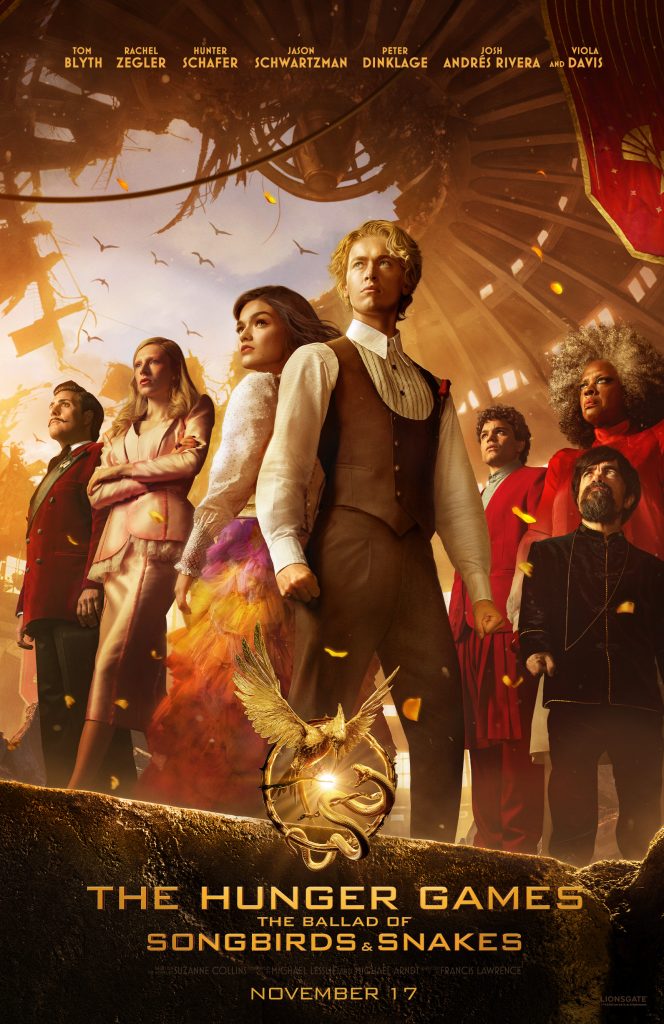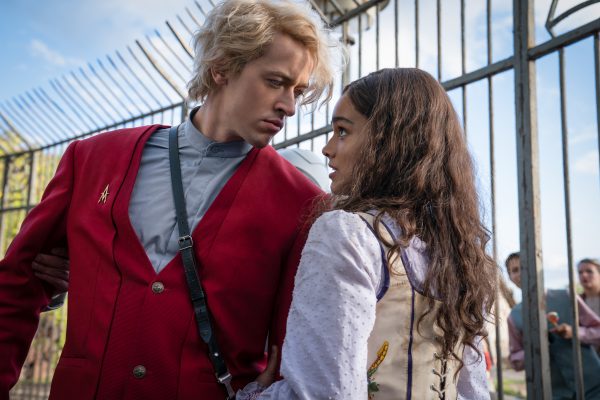If you have a favorite music video from the late-90s through 2011, there’s a good chance it was directed by Francis Lawrence. Bringing that same sensibility to feature films, Lawrence made music at the box office in a career that began with such titles as Constantine, I Am Legend, and Water for Elephants.
Lawrence brought considerable heat to The Hunger Games franchise when he stepped in to direct all three remaining chapters, beginning with The Hunger Games: Catching Fire. The 2013 sequel still holds the franchise record for domestic opening and the highest domestic, international, and global take at $865M worldwide. Based on Suzanne Collins’ dystopian young adult book series, the film franchise has generated nearly $3 billion at the box office and created generations of loyal fans. When Collins returned to Panem with a 2020 prequel, Lionsgate announced the major motion picture adaptation a month prior to the book’s release.
Set 64 years before Katniss Everdeen volunteered as tribute, a young Coriolanus (Tom Blyth) is the last hope of the once-proud and now impoverished Snow family. Attending the Academy in a post-war Capitol, Snow is assigned to mentor District 12 tribute Lucy Gray Baird (Rachel Zegler) in the 10th annual Hunger Games. Harnessing Lucy Gray’s charm, Snow senses an opportunity to shift the odds in their favor. With the games about to begin, Boxoffice Pro discusses the origin story with director Francis Lawrence and how the prequel provides a unique perspective on a familiar franchise.
When you attended The Hunger Games exhibition in 2015, you talked about that being a surreal experience, seeing several years of your life come together in an exhibit. What has the return to this universe been like for you?
It’s been really exciting. I will say, in 2015, we thought it was really the end. Part of the end was seeing that exhibition in the museum. It was very moving, because you start to realize how important these movies and stories are to people’s lives, but it felt like it was a chapter that was over. One that I was very proud of. When Suzanne surprised us with the fact that she was almost done with another book in 2019, it was really exciting to think, “Hey, we can jump back in, we can expand the world, we can all work together again. It would be really fun.”
Has adapting beloved material been happenstance or by design?
Kind of happenstance. I work on a fair amount of adaptations. I mean, jeez, pretty much everything I’ve done is an adaptation from a book actually. I definitely read spec scripts too [Laughs.] I think it just happened to be what I’ve ended up working on.
Music plays a vital role in this story, with District 12 leaning into its Appalachian feel. How has your career and extensive background in music videos played into your films? Do you think musically as a director?
I do think musically as a director. I think music becomes a big reference point for me, usually very early on in the process. I’ll start making playlists and thinking about music. I’ll listen to music on set sometimes. Sometimes in one ear I’ll have music playing and I’ll have the scene and dialogue in the other ear. Sometimes I’ll play music for the actors. Obviously music plays a big part in the cutting and early on in the cutting process before the composer gets involved. I definitely think musically. Music has a huge influence on emotion, impact, and tone, which I think is really key. It’s a huge, huge factor for me.
From the casting of Rachel Zegler as Lucy Gray Baird, to the expansion of Jason Schwartzman’s role as Lucretius “Lucky” Flickerman, we’ve heard a number of behind-the-scenes stories that have shaped the film. What was your shoot like?
It was a pretty good shoot. The good thing about these movies in general, the originals and this one too, [is that] they tend to be bonding experiences. People have good team spirit. They fall in love with the stories. There’s a lot of people that are of very similar ages in these movies, so there’s a lot of bonding there. Our key cast really bonded and all the mentors and tributes, they all kind of bonded. So it’s usually a pretty pleasant experience, I have to say.
For the fans of the franchise, how does this film stay true to the world that they know, but also deliver a really fresh experience?
Part of what I loved about reading it the first time was that it very much felt like a Hunger Games story, which is great, but it felt fresh and it felt unique. It didn’t feel like a rehash. We’re doing a very different kind of story. Instead of a young woman’s survival story, we’re telling a young man’s descent into darkness, which was fascinating. The other thing that’s really satisfying for original fans of the movies and books is that it’s an origin story of the whole series in a way, because we’re going so far back. We’re getting the origins of songs, the origins of behavior, the origins of characters, the origins of the games, the origins of symbols and names. I just think that’s going to be really satisfying. Some of it also upends and recontextualizes some of the mythology that I think people are used to.
The previous entries in the franchise were a cultural moment. They opened at midnight screenings before the days of reserved seating. There was such anticipation for Catching Fire in particular. We’ve seen this summer with Barbie and Oppenheimer, and now this fall with Taylor Swift, that those cultural moments can still happen. Now that new generations are discovering the books and the films, what is this moment like–having fans old and new come together in a movie theater?
I’m a big fan of the theatrical experience. I think everybody talks about immersion and the size of the screen and the sound quality and all of that, which is one huge thing. Honestly, I like nothing more than this movie in IMAX. It’s got a great sound and you can see it on a huge screen. We have a bunch of scenes in the full IMAX aspect ratio. What I will say too, is that when you have a series like this, part of what I think is really great, is that there’s a community that loves these movies, these stories, and these characters.
To be able to sit in a room with fellow community members is a big deal. It’s not just being around other people and just a social experience, but when you’re all embracing this kind of fandom and this community, I think it could be a great thing. Especially when you get into the origins of the story and any nostalgia that might percolate for people who loved the original movies. Even for new people coming in; to come in and feel the energy of fans getting to see and learn about these characters in new ways, I think could also be really exciting.
Speaking of IMAX and Catching Fire, that infamous change in aspect ratio, when Katniss enters the arena, was like Dorothy stepping into Technicolor. What was your experience like working with IMAX this time around?
It’s great. I’m a fan of the theatrical experience. I also love the large format experience. My cinematographer Jo Willems and I have honestly, even with a TV show we did, started using large format digital cameras. So we’re shooting with the large format sensors and those lenses anyway. As soon as we were going to get into this, it was like, “Yeah, let’s do an IMAX version. Let’s pick the spots where we open up and go giant with it.” It was great. There was a moment, I think because of Dune: Part Two, where it felt like we weren’t going to actually get any IMAX screens, which was a bummer. I’m glad we held and finished our IMAX version, because we got the IMAX screens and I’m super excited about it.
This novel in particular includes a lot of world-building. What were those conversations like with your collaborators, in creating this universe again, but many years earlier?
The period aspect of this gave us a bunch of freedom. That was really, really fun. I love Uli Hanisch, who is the production designer. He’s Berlin based and I’ve loved a bunch of his work. He and I got on the phone and started talking about the movie and the story. We sort of landed on reconstruction era Berlin, because we’re in a world that’s not long after a war. So we thought, let’s look at Berlin after World War II in the late 40s, early 50s, when they’re cleaning the rubble out of the streets, rebuilding what’s there, putting up new buildings. What does that look like and feel like?
Once we had that, that informed a lot in terms of architecture and the layout of the Capital. It also started to inform automotive design, hair, makeup, wardrobe. We needed technology to be much more rudimentary in this movie, so we started to look at that era for the technology as well. That time became our guiding light visually.
Our own technology has changed so rapidly since the original films. Did technology create new opportunities for the prequel?
Of most of the movies that I’ve done, I will say that this was not the most challenging visual effects movie that I’ve done. There are certain sequences that are tough, the bombing sequence is tough, the big snake sequence in the arena is a tough one. There’s a lot of animation going on there. Not easy by any means, but in terms of the grand scheme of things, it was not the most challenging.
Technology definitely helps in certain ways. 10 years ago, doing a scene where you’ve got a young woman who’s getting completely covered in snakes would have been a much tougher thing. When you have to basically replace her body digitally, replace the dress digitally, put the digital snakes on and have them interact with a lace dress. There’s complicated moments in there that I think people are just more well equipped to tackle now.
Many of your frequent collaborators are back for this installment, including cinematographer Jo Willems, editor Mark Yoshikawa, and composer James Newton Howard. What was the experience like coming back together for another Hunger Games installment?
That’s always great. I think the truth for me is that, over the years, starting even with music videos, you start to build a group of people that you really respect. You really trust their taste, admire their taste, and like them as people. We go and make these movies and we move away from our families and we’re living together in foreign countries for a year at a time. So it’s always great to go back to this group of people. To care about something and make something together.
Do you have a favorite moviegoing memory or experience?
I have many. I think my favorite theatrical experience was when I went and saw Apocalypse Now. It was a 70mm remaster at the Cinerama Dome. And it was not one of the newer cuts. It was the original cut. That was the best moviegoing experience I think I’ve ever had.




Share this post